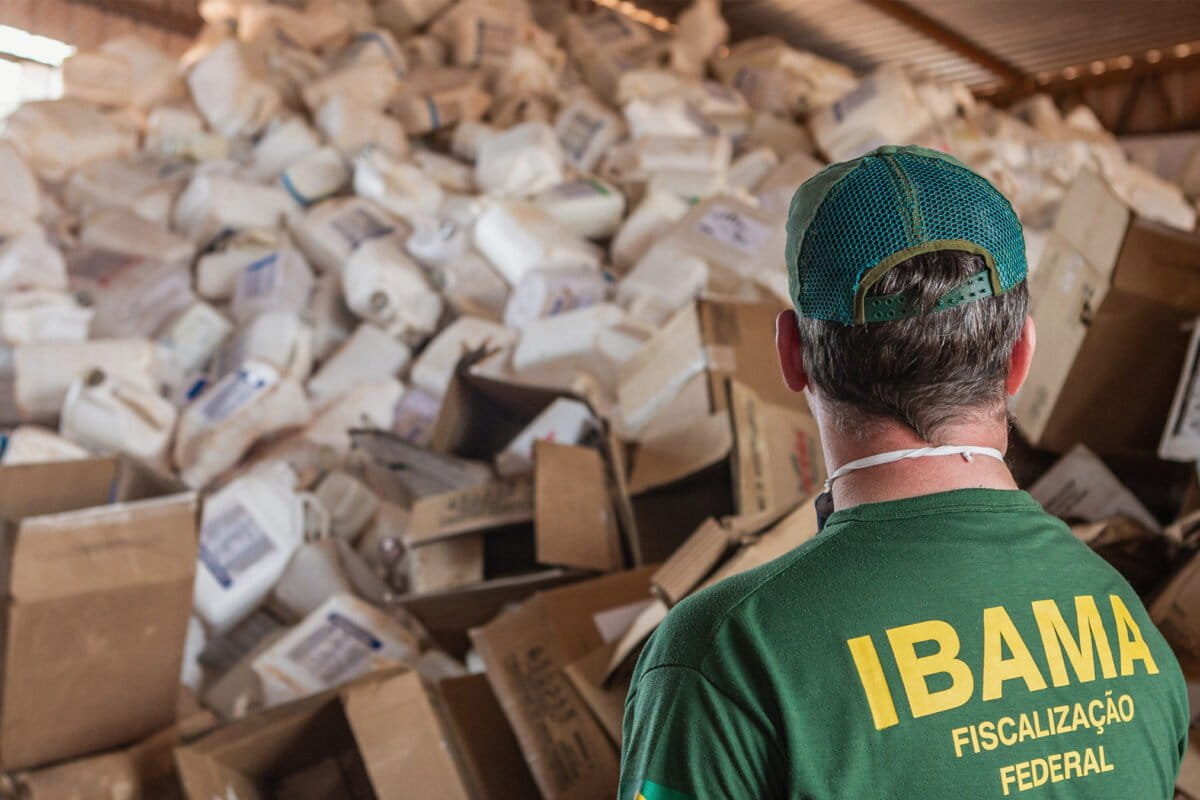- According to new research, for every 5 tons of soy per hectare produced in the Brazilian Amazon and Cerrado, an equivalent of one out of 10,000 children under 10 succumbed to acute lymphoblastic leukemia five years later.
- The researchers estimate that 123 childhood deaths during the 2008-19 period are associated with exposure to pesticides from the soy fields, amounting to half the deaths of children under 10 from lymphoblastic leukemia in the region.
- Experts say that the research is just the tip of the iceberg, and many other diseases and deaths may be associated with chemicals used in crops; further studies are needed.
When Marin Elisabeth Skidmore visited Brazil in 2019, she heard rumblings among the locals about elevated childhood cancers and tragic premature deaths. At that time, she was conducting research in the state of Rondônia, a sparsely populated area in west Brazil that was pressing up against the edge of the Amazon Rainforest. The region, like many other locales encroaching upon the rainforest stronghold, was facing a boom in soybean production.
Cleared tracts that were once used for livestock grazing were rapidly repurposed for growing soybeans. With this transition from pastureland into cropland came a spike in pesticide use over the years.
These pesticides, the community leaders bemoaned, were likely behind the rise in pediatric cases of leukemia.
The link between agricultural chemicals and cancer risk has been previously established by medical experts. But few studies had mapped these substances’ footprint at a population level in Brazil. After Skidmore returned home to the United States, she crunched the numbers. Her latest study in the journal PNAS reports that Brazil’s rise in soybean production may have come at a cost: between 2008 and 2019, an estimated half of the leukemia deaths of children under 10 in soy-expansion regions were connected with pesticide exposure.
“We’re just seeing new populations being exposed to these pesticides that have not been exposed in years prior,” Skidmore tells Mongabay, now an applied economist at the University of Illinois at Urbana-Champaign. “We want to shed light on the costs and benefits of this [agricultural] intensification.”
Brazil is the world’s leading producer of soybeans. The country has had a growing interest in the crop since the mid-last century, but production ramped up in earnest in the 1990s when commodity prices soared and demand from China ballooned. Around that time, research by the Brazilian Agricultural Research Corporation, Embrapa, developed soy varieties that allowed the bush to expand from their historical plantations in the cooler south to the tropics.
The early plots in the north were former cattle grounds that had seen little chemical input before then. With the transition in land use, the same fields were now showered with fungicides, insecticides, herbicides and other synthetic substances.

Farmers wielded — and still wield — these pesticides liberally, enabled by loose, agribusiness-friendly legislation on these chemicals, many of them hazardous. Brazil is the world’s second-largest consumer of pesticides, applying them at a per-hectare rate that’s 2.3 times higher than that of the U.S. and three times higher than China, according to the study. The South American nation even imports pesticides from European countries that have banned these chemicals on their home soil.
The shift to soy in the lower-latitude regions was one inadvertent but natural experiment for studying the public health impact of pesticide use, one that Skidmore wanted to take advantage of. Her team scoured 15 years of childhood mortality data related to acute lymphoblastic leukemia in the Cerrado and the Amazon. The swathes of land here were major hubs for soy expansion. Between 2000 and 2009, soy acreage in the Cerrado savanna in central Brazil tripled; in the neighboring Amazon northward, the increase was by a factor of 20.
By looking at the number of childhood cancer deaths in the regions that switched to soy, the study authors found a strong geographical link. For every 5 tons of soy per hectare produced, a proxy for pesticide use in the region, an equivalent of one out of 10,000 children under 10 succumbed to acute lymphoblastic leukemia five years later. The researchers calculated that 123 childhood deaths during the 2008-19 period were associated with exposure to pesticides from the soy fields.
Children were unlikely to be working in the soy fields, but the researchers hypothesized that they were potentially exposed to pesticides through the water supply. To clarify this association, the researchers used satellite data to identify soy-covered basins along Brazil’s river network. Watershed regions growing more soy upstream had a higher pediatric cancer mortality rate among its residents.
The study doesn’t necessarily pin the cause of cancer on pesticide exposure — confirmation studies would require deliberately exposing people to the carcinogens and then monitoring health outcomes, which is unethical. But “it’s alarming data,” says Beate Ritz, an environmental and occupational epidemiologist at the University of California, Los Angeles.
The new research makes a compelling case for further tests, such as measuring water contamination, which could strengthen the study’s argument and spur the enactment of new health measures.

Tip of the iceberg
A similar analysis was carried out in the state of Mato Grosso by the news outlet InfoAmazonia in collaboration with the Fiocruz research center. In municipalities with at least 5% of the area dedicated to soy, their women, children and adolescents had a 26-33% greater risk of developing and dying from leukemia or lymphoma.
As dire as the new study’s results are, the mortality numbers themselves are likely an underestimation of pesticides’ hazards, says Rafael Junqueira Buralli, an occupational health epidemiologist at the University of São Paulo who wasn’t involved in the study. Crops besides soy could have also incurred heavy use of hazardous pesticides (though soy farming admittedly guzzles the most). Other routes of pesticide exposure are possible, such as by proximity, as the chemicals drift from plot to plot.
Moreover, acute lymphoblastic leukemia is only one manifestation of the pesticides’ public health impact; Buralli’s own research has found that farmers in chronic contact with pesticides also experienced respiratory and neurological side effects.
“Childhood leukemia is probably just the tip of the iceberg of everything else that could be coming along with heavy pesticide use,” Ritz tells Mongabay.
Fortunately, acute lymphoblastic leukemia is curable, but it requires daily and long-term care for pediatric patients to make a full recovery. Skidmore’s study found a higher number of leukemia deaths in municipalities that were more than 100 kilometers (62 miles) from a cancer treatment center, compared with those situated closer to medical facilities. In these remote sites, the lack of accessible oncology services translated to an additional 32 pediatric deaths per million residents. Another insidious effect of pesticide exposure: It lays bare spatial inequalities in healthcare.
“There are agricultural villages in the Amazon where people need [to travel] 8-12 hours by boat to reach a big city” where the nearest hospital could be, Buralli says. So it’s possible that youths could have died from health complications without a proper diagnosis, he adds.
The soybean boom may have enriched the nation’s coffers, but the public health costs dampen soy’s success. “We don’t advocate for a wholesale stop to pesticide use — that would have really big ramifications for global food supply,” Skidmore says. “The question is, how do we minimize the public health risks?”
Improving health care access in farming regions would help catch cancers and treat them early. Toward that end, the authors recommend regular cancer screenings in agricultural communities. Education on safe and judicious pesticide application may also help reduce the chemical’s environmental spread.
Regulating the chemicals may seem like a no-brainer solution, but “it’s very difficult to see that happening in Brazil,” says Buralli, for the ruralist political landscape may hamper any such policies. Buralli says he would like to see regular revisions of the approved chemicals list when new research on chemical safety rolls in. During Jair Bolsanaro’s presidency from 2019-22, more than 1,000 pesticides were authorized, many of them toxic — and they’ll likely remain in circulation in the environment for perpetuity unless someone with legal clout calls for a reevaluation. It’s time for the country to reckon with its agricultural practices and opt for sustainability, Buralli says, to ensure that economic progress doesn’t come at the expense of community health.
Banner image: Brazilian environment agency, IBAMA, carrying out an operation to combat the illegal use of pesticides in the Cerrado in 2018. Image by Vinícius Mendonça/Ibama via Wikimedia Commons (CC BY 2.0).
Poisoned by pesticides: Health crisis deepens in Brazil’s Indigenous communities
Citations:
Sabarwal, A., Kumar, K., & Singh, R. P. (2018). Hazardous effects of chemical pesticides on human health–cancer and other associated disorders. Environmental Toxicology and Pharmacology, 63, 103-114. doi:10.1016/j.etap.2018.08.018
Skidmore, M. E., Sims, K. M., & Gibbs, H. K. (2023). Agricultural intensification and childhood cancer in Brazil. Proceedings of the National Academy of Sciences, 120(45), e2306003120.
Spehar, C. R. (1994). Breeding soybeans to the low latitudes of Brazilian Cerrados (Savannahs). Pesc Agropecu Bras. Retrieved from https://ainfo.cnptia.embrapa.br/digital/bitstream/item/212883/1/Breeding-soybeans-to-the-low.pdf
FEEDBACK: Use this form to send a message to the author of this post. If you want to post a public comment, you can do that at the bottom of the page.
